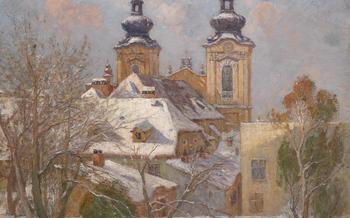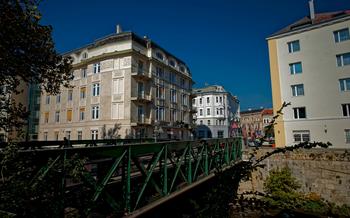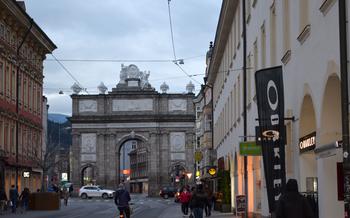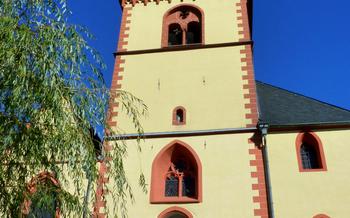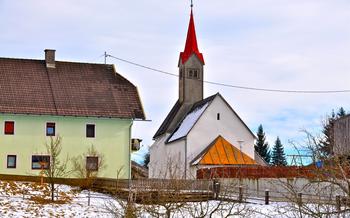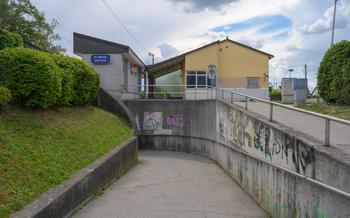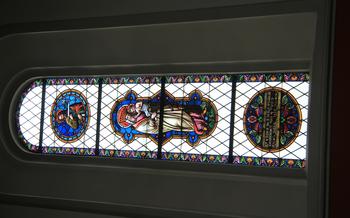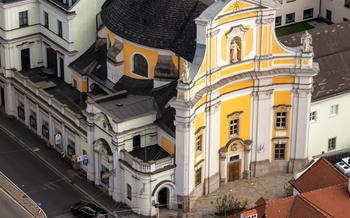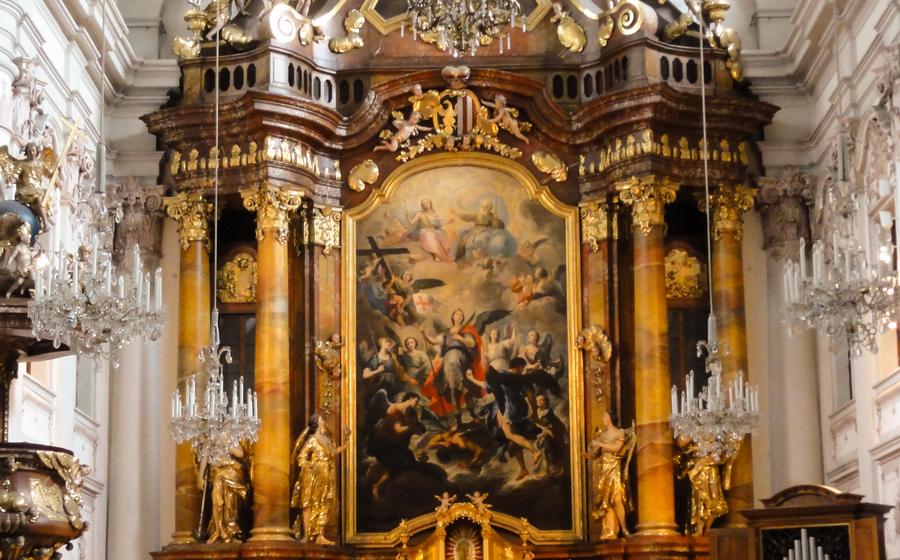
The Linz Carmelite Church
- History of the Linz Carmelite Church
- Architectural Features
- Carmelite Order and Its Significance
- The Linz Carmelite Church Museum
- Concerts and Events
- Interior Artwork and Decorations
- Spiritual Significance
- Peace and Serenity
- Historical Significance
- Accessibility
- The Church's Surroundings
- Local Traditions and Customs:
- Photography Opportunities:
- Insider Tip: The Hidden Crypt
History of the Linz Carmelite Church
Founded in 1674 by Emperor Leopold I, the Linz Carmelite Church stands as a testament to the deep-rooted Catholic faith of the city's inhabitants. Its construction, completed in 1736, reflects the Baroque architectural style prevalent during that era. The church's imposing façade, adorned with intricate carvings and statues, hints at the grandeur that awaits within. During World War II, the church, like many other historical landmarks in Linz, suffered substantial damage from Allied bombings. However, thanks to the tireless efforts of the local community and the dedication of skilled restoration experts, the church was meticulously restored to its former glory, reopening its doors to the faithful in 195Today, the Linz Carmelite Church stands as a symbol of resilience, faith, and the enduring spirit of the city.
Architectural Features
The Linz Carmelite Church stands out for its remarkable architectural features, showcasing a harmonious blend of Gothic and Baroque styles. The impressive façade captivates visitors with its intricate details and decorative elements. Its grand entrance, adorned with delicate carvings and sculptures, invites them into a world of artistic wonders. Above the entrance, a magnificent rose window, intricately crafted with colorful stained glass, allows sunlight to filter in, creating a mesmerizing play of light and shadow.
Upon entering the church, one is immediately struck by the awe-inspiring interior. The vaulted ceilings, reaching towards the heavens, create a sense of grandeur and spirituality. The walls are adorned with stunning frescoes, depicting biblical scenes and the lives of saints, inviting visitors to contemplate their religious significance. The intricate carvings and sculptures that adorn the interior add a touch of elegance and opulence, contributing to the church's overall aesthetic appeal.
One of the most notable features of the Linz Carmelite Church is its beautiful stained glass windows. These exquisite works of art, crafted with vibrant colors and intricate designs, depict various religious scenes and figures. The windows allow natural light to flood into the church, creating a kaleidoscope of colors that illuminates the interior and adds to its serene atmosphere.
The Baroque-style altar, a masterpiece of craftsmanship, is another highlight of the church. Its intricate carvings, delicate details, and golden ornamentation create a sense of awe and reverence. The altar serves as the focal point of the church, where religious ceremonies and rituals are conducted. Its grandeur and beauty symbolize the importance of faith and devotion in the lives of the faithful.
Carmelite Order and Its Significance
The Carmelite Order, founded in the 12th century on Mount Carmel in the Holy Land, is a Catholic religious order known for its contemplative and eremitical way of life. The Carmelites follow a strict rule of life based on the teachings of the prophet Elijah, emphasizing prayer, solitude, and community.
The order's spirituality is centered on the Incarnation of Jesus Christ and devotion to the Virgin Mary, whom they regard as their patroness. Carmelites strive to live in union with God through contemplation, prayer, and the practice of virtue.
In Linz, the Carmelites have been present since the 17th century, playing a significant role in the city's religious and cultural landscape. The order established a monastery and church, which became a center of spiritual and intellectual activity. The Carmelites were instrumental in promoting education and social welfare in Linz, founding schools, hospitals, and charitable institutions.
Throughout their history, the Carmelites have been dedicated to serving the community, providing spiritual guidance and support to the people of Linz. Their commitment to prayer and contemplation has made the Linz Carmelite Church a place of peace and refuge for many seeking solace and connection with the divine.
The Linz Carmelite Church Museum
Within the walls of the Linz Carmelite Church lies a treasure trove of history and spirituality—the Linz Carmelite Church Museum. This hidden gem, nestled in the heart of the church, offers visitors a glimpse into the rich past and vibrant present of the Carmelite Order in Linz.
The museum showcases a diverse collection of artifacts, documents, and artworks that narrate the story of the Carmelites' arrival and their profound impact on the city's religious and cultural landscape. Visitors can trace the order's humble beginnings, admire liturgical vestments and sacred objects, and delve into the spiritual practices and beliefs that have shaped the Carmelite way of life for centuries.
Among the highlights of the museum's collection are rare manuscripts, intricate sculptures, and stunning paintings that reflect the artistic and devotional traditions of the Carmelite Order. These works of art not only beautify the museum's space but also provide a deeper understanding of the Carmelites' spirituality and their commitment to spreading the message of God's love.
The Linz Carmelite Church Museum is a testament to the enduring legacy of the Carmelite Order in Linz. It invites visitors to embark on a journey of faith, history, and art, offering a unique perspective on the spiritual and cultural heritage of this remarkable city.
Concerts and Events
The Linz Carmelite Church is renowned for its exceptional acoustics and atmosphere, making it a sought-after venue for classical concerts and musical events. The church's grand interior and vaulted ceilings create an immersive and intimate setting for performances, allowing the music to resonate and envelop the audience.
Throughout the year, the church hosts a diverse range of concerts, featuring talented musicians and ensembles from Linz and beyond. From classical recitals to choral performances and organ concerts, there is something to suit every musical taste. Visitors can immerse themselves in the harmonious sounds of Mozart, Bach, and other renowned composers, while appreciating the church's sacred ambiance.
For those seeking a truly unforgettable musical experience, attending a concert at the Linz Carmelite Church is a must. The church's acoustics and atmosphere transform each performance into a magical and moving event, leaving a lasting impression on visitors.
To find out more about upcoming concerts and events, visitors can check the church's website or contact the parish office. Ticket prices vary depending on the event, and advance booking is recommended to secure the best seats.
Interior Artwork and Decorations
The Linz Carmelite Church is adorned with stunning frescoes that grace its walls and ceilings. These intricate paintings depict biblical scenes, the lives of saints, and allegorical representations of faith and devotion. The vibrant colors and skillful brushstrokes bring these stories to life, inviting viewers to contemplate their deeper spiritual meanings.
The church's interior also features exquisite carvings and sculptures that showcase the artistry and craftsmanship of the Baroque period. These ornate embellishments can be found on the pulpit, the altar, and throughout the church's many niches and alcoves. Each piece tells a story, adding to the overall narrative of the church's rich history and religious significance.
Of particular note are the Stations of the Cross, a series of 14 sculptures that depict the final hours of Jesus' life. These poignant works of art capture the emotions and suffering of Christ, inviting viewers to reflect on the significance of his sacrifice. The Stations of the Cross serve as a powerful reminder of the church's central message of redemption and salvation.
In addition to the frescoes, carvings, and Stations of the Cross, the Linz Carmelite Church is home to several notable paintings and artworks. These include a beautiful altarpiece depicting the Virgin Mary with the infant Jesus, as well as a series of stained glass windows that cast a colorful glow upon the interior.
Spiritual Significance
The Linz Carmelite Church holds great spiritual significance for Catholics in the city and beyond. It serves as a place of worship, pilgrimage, and spiritual renewal. The church is dedicated to the Virgin Mary, and many devotees come here to pray and seek her intercession. The Eucharist, the central sacrament of the Catholic faith, is celebrated daily at the church, attracting a large number of worshippers. The sacrament of reconciliation is also available, providing an opportunity for individuals to confess their sins and receive God's forgiveness. The church promotes devotion and spirituality among the local community through various initiatives, such as prayer groups, Bible studies, and retreats. Special religious events and observances, such as Mass on holy days and the celebration of feast days, are held throughout the year, attracting both locals and visitors. The Linz Carmelite Church is a sacred space where individuals can find solace, reflection, and a deeper connection with their faith.
Peace and Serenity
The Linz Carmelite Church exudes an aura of peace and serenity that invites visitors to find solace and reflection within its sacred walls. Step inside this magnificent sanctuary and let the tranquility envelop you. The gentle glow of candles illuminates the intricate details of the interior, casting a warm and inviting light. The soft echoes of footsteps on the marble floors add to the sense of calm, creating an atmosphere conducive to contemplation and spiritual connection. Whether you are a devout Catholic seeking a place of worship or simply a traveler in search of inner peace, the Linz Carmelite Church offers a sanctuary where you can escape the hustle and bustle of city life and find a moment of respite. Consider visiting during off-peak hours, when the church is less crowded, to fully immerse yourself in its tranquil ambiance.
Historical Significance
The Linz Carmelite Church holds immense historical significance, deeply intertwined with the city's religious and cultural identity. Since its consecration in 1736, the church has witnessed and survived numerous historical events, leaving an indelible mark on its story. During the turbulent period of World War II, the church miraculously escaped destruction despite the heavy bombings that ravaged Linz. This remarkable survival stands as a testament to its resilience and enduring importance. Notable historical figures, including emperors, bishops, and prominent citizens, have graced the church's halls, adding to its rich tapestry of history. As a symbol of faith and fortitude, the Linz Carmelite Church continues to play a pivotal role in shaping the city's historical narrative.
Accessibility
The Linz Carmelite Church is easily accessible by public transportation. Several bus lines stop nearby, and the Linz Hauptbahnhof (main train station) is within walking distance. For those traveling by car, there are several parking garages and street parking options in the vicinity. The church is also wheelchair accessible, with ramps and elevators providing easy access to all areas. For those staying further away, consider renting a bicycle or using a ride-sharing service to reach the church.
The Church's Surroundings
The Linz Carmelite Church is nestled in a charming and historic neighborhood, inviting visitors to explore beyond its sacred walls. A short stroll from the church, visitors can discover the beautiful Volksgarten, a serene park with lush greenery and tranquil walking paths. The nearby Museum of Nature and Society offers a fascinating glimpse into the region's natural history and cultural heritage.
For those seeking a taste of local cuisine, the neighborhood is home to a variety of cozy cafes and traditional Austrian restaurants. Indulge in mouthwatering pastries at Konditorei Jindrak, or savor authentic Austrian dishes at Gasthaus Ramsauer, a beloved local institution.
To enhance your visit, consider exploring the Landstraße district, known for its vibrant shopping streets and elegant architecture. Discover unique boutiques, charming bookstores, and art galleries, or simply admire the stunning facades of the historic buildings lining the streets.
Combining a visit to the Linz Carmelite Church with a leisurely stroll through the surrounding neighborhood promises a delightful and enriching experience, allowing visitors to immerse themselves in the city's rich history, culture, and charm.
Local Traditions and Customs:
The Linz Carmelite Church is deeply integrated into the lives of the local community. Throughout the year, the church hosts special religious festivals and celebrations that attract both parishioners and visitors alike. One of the most significant events is the annual Carmelite Feast, held in honor of the order's patron saint, Our Lady of Mount Carmel. During this festival, the church is adorned with colorful decorations, and a special Mass is held to celebrate the occasion. Visitors can also witness traditional processions and festivities that showcase the vibrant religious traditions of Linz. Participating in these local customs and traditions is a wonderful way for visitors to immerse themselves in the city's rich cultural heritage and gain a deeper understanding of the role the Carmelite Church plays in the community.
Photography Opportunities:
The Linz Carmelite Church presents a treasure trove of photographic opportunities for enthusiasts of all skill levels. The church's striking architecture, intricate interior, and abundance of natural light create a photographer's paradise. To capture the church's grandeur, position yourself at the entrance to capture the sweeping view of the nave and altar. For a unique perspective, ascend to the choir loft and shoot down the length of the church, showcasing its impressive vaulted ceilings. Don't miss the opportunity to immortalize the church's stunning stained glass windows, which bathe the interior in a kaleidoscope of colors. To fully appreciate the intricate details of the Baroque-style altar, get up close and capture its ornate carvings and sculptures. Remember to be respectful during religious services and avoid using flash photography. For steady shots, consider bringing a tripod to ensure sharp and blur-free images.
Insider Tip: The Hidden Crypt
Beneath the Linz Carmelite Church lies a hidden gem known as the crypt. This subterranean chamber is a treasure trove of history and spirituality, accessible through a discreet entrance near the altar. Visitors who venture into the crypt will be rewarded with a glimpse into the past as they explore the final resting places of former priests, nobles, and prominent figures from Linz's history. The air is filled with a sense of reverence and mystery, making it a truly unique and unforgettable experience. Discover the hidden crypt and delve into the depths of the Linz Carmelite Church's rich history.
